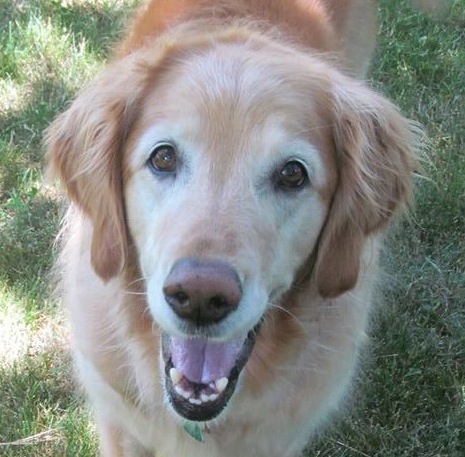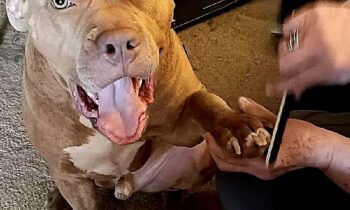
Is your dog a treat grabber? Does she nibble at your fingertips when you’re handing her a treat? Have you been bruised by her canine teeth when she bit down on you instead of on the biscuit? Does she trail the children around the house, licking their hands or stealing the food they’re eating?
Snatching food (or objects) from human hands—with the use of teeth, paws, or some other sort of puppy-powered force—is a common problem among pet dogs. It’s also one that, in most cases, can be easily solved with one simple exercise practiced throughout the dog’s life.
What’s the answer? Doggy Zen!
That’s what trainers call it, this method of teaching your dog that mouthing hands and grabbing at treats or food or objects will not get them what they want (the treat, food, or object).
It’s a simple exercise that can be taught totally non-verbally. No cues to remember, no words to say. In fact, the quieter you can be, the more it will help your dog to concentrate and learn. Later, this “baby beginner” exercise can form the basis of some very important behaviors.
What you need:
- Small, tasty, smelly treats. Use treats made for very small dogs (so you can do a lot of repetitions) or prepare your own from turkey hot dogs, tube meat, or cooked chicken.
- Your dog—hungry.
What you do:
- Give a few small samples to the dog by throwing the treats on the floor.
Your dog will indicate her level of interest in the treats you’ve chosen, either by glomming on to them immediately and swallowing them with pleasure . . . or by rejecting them completely, leaving them on the floor.
Obviously, if the treats are rejected, it’s time to stop and search for treats that won’t be rejected! You know what to do.
- Stand in front of the dog, holding out your hand with a (sampled and approved) treat in your palm.
- Your dog should quickly try to get that treat, one way or another.
- Close your palm over the treat before your dog can grab it.
Dogs with poor or no bite inhibition are not suitable for this lesson. If you have any reason to believe that your dog will try to bite the treat out of your closed hand, do not do this training. Be careful!
- Your dog will offer many behaviors to try to get the treat. First, expect some mouthing, licking, pushing, and pawing at your closed hand.
Second, expect the dog to offer any behavior that she knows has resulted in a treat in the past. Many dogs who’ve recently learned to Sit for a treat will “throw” a sit at you. It’s worked before; they hope it will work again. Don’t react, and try not to giggle at your dog’s antics. This is serious stuff!
- Open the hand to offer the treat the second the dog is not touching your hand.
- Let the dog eat the treat.
- Start again.
It’s that simple: the dog gets the treat for not trying to get the treat. That’s why it’s called Doggy Zen.

What’s the point of teaching the dog not to try to get the treat from your hand?
This exercise is the basis for the much more advanced training you will do once your dog gets the concept of Doggy Zen (not trying to get the treat, but waiting until it’s given). Eventually, you will work up to being able to place the treat on the floor, or on an object, while your dog waits without trying to get it. That’s the foundation of “Leave It” exercises in which your dog learns to ignore treats placed where she could get them if she tried . . . because she knows she’ll get the treat only if she doesn’t try.
You may have seen photos on the internet of dogs in Down or Sit Stays with the words LEAVE IT spelled out in dog kibble or dog biscuits on the floor in front of the dog. I saw such a photo the other day in which a whole group of dogs, all sizes, all breeds, were lined up in Sit Stays with delicious treats in front of them—treats they were ignoring because they knew that going for the treat meant they wouldn’t get it. It takes a lot of practice to work up to that kind of excellent behavior. Right now, we’re working only on the dog’s not trying to get a treat from your hand.
Dogs with a great deal of self-confidence normally may take a while to catch on to Doggy Zen, especially if they’ve been nabbing treats from human hands for a long time already. Expect to see those dogs try again and again to get to that treat concealed in your closed fist, using one behavior after another to crack the code. Don’t let them force you to open that hand. Be patient!
Dogs who tend to be more shy—especially those who have ever been hand-shy (afraid of human hands because human hands make bad things happen, like getting hit)—may fall on the other side of the spectrum. Rather than trying repeatedly to get to that treat in your hand, shyer dogs may back off completely, showing no interest in going for the treat. Take it very easy on those dogs. It is not that they are trying to avoid the lesson; they’re trying to avoid a bad experience such as they’ve had in the past. Consider working on their hand-shy issues first before you teach them Doggy Zen. Be kind!
Standing in front of your dog when you first start to work on Doggy Zen is advisable. It gives you the height advantage. But don’t stop there.
- When your dog has practiced Doggy Zen for some time with you standing, try working on the same exercise with you sitting in a chair.
Things can look completely different to your dog when your body position is changed. You want the dog to understand that Doggy Zen is expected no matter what position your body is in.
- Next, try sitting on the floor. Then lie down!
- Work inside in a quiet space at first, with no distractions.
- When your dog masters the exercise with no distractions, move on to working in a noisier, busier space in your home, then outdoors in your back yard, then on your front porch, then on a walk around the neighborhood.
- Add new places, people, and things to the atmosphere as your dog succeeds.
- The treat is the reward. Your dog must want it.
- To get the treat, your dog must not try to get the treat.
- Your dog gets the treat the second she stops trying to get the treat.
How your dog stops trying to get the treat is up to her at this point. She may sit in front of you. She may lie down. She may back some distance away from you (you can throw the treat if you wish).
It’s your timing in rewarding the “not trying to get the treat” that is most important. The treat must be given immediately that the dog stops trying to get it. You may practice with other humans first if you’re unsure of how good your timing is. Ask a friend or relative (kids are very useful) to “be the dog”!
Practice several times a day, when your dog is hungry. Reduce the amount of your dog’s regular food if “too many treats” might create weight issues. Limit the length of your training sessions to a few minutes only. Quit while you (and your dog) are ahead. Always leave the dog wanting more! Work up to more distracting situations slowly, and be prepared to go back to earlier steps in the training as necessary. Teach other adults how to play Doggy Zen and ask them to help with training your dog.
Doggy Zen teaches your dog how to get what she wants by not taking it from you.



